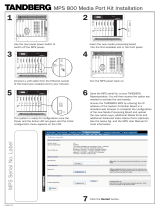
D13841.08
10.2007
7
TANDBERG 3G GATEWAY
USER GUIDE
Table of
Contents
Trademarks &
Copyright
Patents &
Disclaimers
Safety/
Environmental
To Get You
Up and Going
Using the 3G
Gateway
Viewing the
System Status
Configuring
the 3G Gateway
Maintenance
& Upgrade
Services
Dial Plan
Examples
Contact
Information
Safety/
Environmental
TANDBERG 3G GATEWAY
USER GUIDE
For your protection please read these safety
instructions completely before you connect
the equipment to the power source. Carefully
observe all warnings, precautions and
instructions both on the apparatus and in these
operating instructions.
Retain this manual for future reference.
Water and Moisture
Do not operate the apparatus under or near •
water – for example near a bathtub, kitchen
sink, or laundry tub, in a wet basement, near
a swimming pool or in other areas with high
humidity.
Never install jacks for communication
•
cables in wet locations unless the jack is
specifically designed for wet locations.
Do not touch the product with wet hands.
•
Cleaning
Unplug the apparatus from communication •
lines, mains power-outlet or any power
source before cleaning or polishing. Do not
use liquid cleaners or aerosol cleaners. Use
a lint-free cloth lightly moistened with water
for cleaning the exterior of the apparatus.
Unplug the apparatus from communication
•
lines before cleaning or polishing. Do not
use liquid cleaners or aerosol cleaners. Use
a lint-free cloth lightly moistened with water
for cleaning the exterior of the apparatus.
Ventilation
Do not block any of the ventilation openings •
of the apparatus. Never cover the slots and
openings with a cloth or other material.
Never install the apparatus near heat
sources such as radiators, heat registers,
stoves, or other apparatus (including
amplifiers) that produce heat.
Do not place the product in direct sunlight or
•
close to a surface directly heated by the sun.
Lightning
Never use this apparatus, or connect/
disconnect communication cables or power
cables during lightning storms.
Dust
Do not operate the apparatus in areas with high
concentration of dust.
Vibration
Do not operate the apparatus in areas with
vibration or place it on an unstable surface.
Power Connection and Hazardous
Voltage
The product may have hazardous voltage •
inside. Never attempt to open this product,
or any peripherals connected to the product,
where this action requires a tool.
This product should always be powered from
•
an earthed power outlet.
Never connect attached power supply cord
•
to other products.
In case any parts of the product has visual
•
damage never attempt to connect mains
power, or any other power source, before
consulting service personnel
The plug connecting the power cord to the
•
product/power supply serves as the main
disconnect device for this equipment.
The power cord must always be easily
accessible.
Route the power cord so as to avoid it being
•
walked on or pinched by items placed upon
or against it. Pay particular attention to the
plugs, receptacles and the point where the
cord exits from the apparatus.
Do not tug the power cord.
•
If the provided plug does not fit into your •
outlet, consult an electrician.
Never install cables, or any peripherals,
•
without first unplugging the device from it's
power source.
Servicing
Do not attempt to service the apparatus •
yourself as opening or removing covers may
expose you to dangerous voltages or other
hazards, and will void the warranty. Refer all
servicing to qualified service personnel.
Unplug the apparatus from its power source
•
and refer servicing to qualified personnel
under the following conditions:
If the power cord or plug is damaged or
•
frayed.
If liquid has been spilled into the
•
apparatus.
If objects have fallen into the apparatus.
•
If the apparatus has been exposed to rain •
or moisture
If the apparatus has been subjected to
•
excessive shock by being dropped.
If the cabinet has been damaged.
•
If the apparatus seems to be overheated. •
If the apparatus emits smoke or abnormal •
odour.
If the apparatus fails to operate in
•
accordance with the operating instructions.
Accessories
Use only accessories specified by the
manufacturer, or sold with the apparatus.
Communication Lines
Do not use communication equipment to report
a gas leak in the vicinity of the leak.
Electromagnetic Compatibility (EMC)
This is a Class A product. In a domestic
environment this product may cause radio
interference in which case the user may be
required to take adequate measures.
EC Declaration of Conformity
MANUFACTURER: TANDBERG Telecom AS
PRODUCT NAME: TANDBERG 3G Gateway
TYPE NUMBER: TTC2-03
DESCRIPTION: Network unit
This product complies with Commission Directives:
LVD 73/23/EEC
EMC 89/336/EEC
R&TTE 99/5/EEC
This product complies with harmonized
Standards:
EN 60950-1 : 2001, A11
EN 55022 : 1994, A1/A2
EN 55024 : 1998, A1/A2
EN 61000-3-2 : 2000
EN 61000-3-3 : 1995, A1
TBR 3 Layer 1, 2 and 3
TBR4 Layer 1, 2 and 3
TECHNICAL CONSTRUCTION FILE NO.: X13526
YEAR WHICH THE CE-MARK WAS AFFIXED: 2005
For an official, signed version of this document,
or details regarding documentation from the
technical construction file, please contact
TANDBERG.
Safety Instructions





























